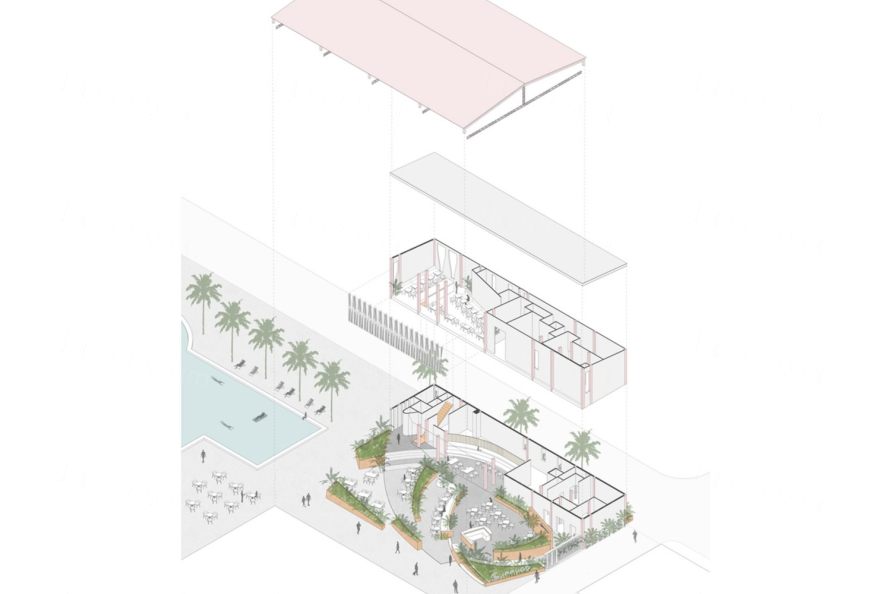远离胡志明市中心的喧嚣,越南一风堂位于南面8公里的第7区。本店是日本一风堂拉面店在越南第一家分店,位于新兴的住宅区内,毗邻一个可供公众使用的公共空间,这是一个将现有的一栋8米高的两层钢结构建筑改建为半室外餐厅的改造项目,面积为540平方米。
Away from the hustle and bustle of Ho Chi Minh City center, Ippudo Vietnam is located at District 7, which is 8km to the South. This is the first branch of a Japanese ramen restaurant, and it is sited in an emerging housing development. Adjacent to a pool that is public-accessible, thisis a renovation project in which an existing 8m-high two-story steel structure building with an area of 540m2 to be converted to a restaurant with a semi-outdoor space.

现有的环境为我们提供了一个创造活动餐饮空间的机会。利用绿植和木筷子作为屏风,为使用者提供隐私,同时也提供和增强了用餐空间的观赏体验。这样做的目的是为了创造一个多层次和令人难忘的空间。
The existing surroundings present an opportunity to create an eventful dining space. Greenery and wooden chopsticks are used as screens to provide privacy for the users yet offer and enhance the viewing experience from the dining space. This is aimed to create a multi-layered and memorable space.
▼项目轴侧分解图 Explode Drawing

郊区比市区更加单调
场地位于七区,是一个新兴的住宅区,已被外来开发商开发。现代城市的发展迅速而单调,高楼林立,商业建筑林立,导致与周边环境缺乏考虑。由于缺乏对人的需求的关注,人们在这种城市化的发展中常常感到格格不入。在越南,具有强烈社区意识的小巷很常见。它被称为"hem",它一直是当地社区形成的核心。通常情况下,建筑的设计都是直接与"hem"相连的,它通常是活动和互动发生的社会环境。在越南,家庭和当地社区在一起吃饭是一种传统,因此在这里形成了强烈的社区意识。为了在越南的一个新城市地区准备这样的餐饮空间,适当的策略来支持这种传统是设计方法的主要策略。
Suburbs more uniform than generic city
The site location, District 7 is an emerging residential area that has been developed by foreign developers. The rapid and monotonous city development with its high-rise residential and commercial buildings resulted in a lack of consideration with its surroundings. Due to the lack of attention to human and pedestrian needs, people often feel out of place within this development. Alleys with strong sense of community are commonly found in Vietnam. It is called “hem”. It has been the core of the formation of local community. Typically, buildings are designed to connect directly to the “hem”. It is often the social setting where activities and interaction take place. It is a tradition in Vietnam where families and local community have meals together. This is where a strong sense of community is formed. In order to prepare such dining space in a new city area in Vietnam, the appropriate strategy to support this tradition is the main theme to the design approach.

层叠的景观、屏风与活动空间
由于这家餐厅位于热带气候区,所以重点是利用植物的能量。通过使用绿色植物,多个绿色屏风的重叠创造了一个多层次的景观,中间的空间就变成了用餐空间,目的是为了提高半户外空间的宽敞性和人性化。绿色植物的屏风非常适合当地的环境,降低了热辐射的同时还能提高美观程度。
Overlaying landscapes, screens and activities
Since this restaurant is located in a tropical climate region, the focus is to utilise the power of plants. By using greenery, a multi-layered landscape is created by overlapping multiple green screens. The in-between space then becomes the dining space. The purpose is to enhance and humanize the spacious semi-outdoor space. Green screen is considered an appropriate material as it features low heat radiation, as well as the aesthetics itself.

客人一到这里,就会被树池和起伏的花盆所吸引。花槽由裸露的回收砖制成,餐厅地板逐渐向树池下降,这是为了将树池作为设计考虑的一部分,同时被重叠的绿植轻轻雕琢。
The guests are greeted by the pool and undulating planters upon arrival. The planters are made of exposed recycled bricks. The dining floor gradually descends towards the pool. This is to include the pool as part of the design consideration while being gently carved by the overlapping greenery.

面向主厨房的弧形台面向外延伸,形成一个较高的平台层,作为二层的入口。非线性的景观进一步提升了用餐区的空间纵深,同时为客人提供了私密性。
The arc-shaped counter facing the main kitchen extends outwards to form a higher platform level, which acts as the entrance to the second floor. The non-linear of the landscape further enhance the spatial depth of the dining area while providing privacy to the guests.


木质筷子屏风作为空间的标志
用木筷子制作的屏风,旨在将当地文化与景观屏风联系起来。这种当地制造的天然材料旨在表达和尊重越南当地的手工艺。
Local made wooden chopstick screen as signature of the space
Screens made by wooden chopsticks are designed to connect the local culture with the landscape screens. This locally-made natural material is aimed to express and embrace Vietnamese craftsmanship.

在夜间,筷子屏风在白天与绿化景观相得益彰的同时,也营造出独特的韵味立面外观。屏风的特点是像窗帘一样的开口,坐着的时候可以提供隐私。当站立时,屏风框架会在人眼水平面逐渐旋转,为客人提供视野。这些由绿植和木筷子屏风组成的多层屏障保护了人们在其间的活动,并在白天和黑夜中创造了一个有丰富深度的景观。
During the night, the chopstick screens create a unique rhythmic façade appearance while complementing the greenery landscape during the daytime. The screen panels feature a curtain-like opening, in which they provide privacy when seated. The frames then gradually rotate at the human eye-level when standing to provide view-out to the guests. These multi-layered screens of green and wooden chopsticks celebrate human activity in between and create a landscape in day and night with a depth.



一个与场地共同成长的空间
建筑的设计尽量保持简洁,它是一个在多层景观之间进行活动和互动的地方,因此这个空间的设计应该是舒适的,并且要与周围的环境想融合。因此,家庭在使用相邻的树池时,会利用舒适的用餐空间作为休息场所,餐厅作为区域内的社交中心,在这里互动和分享食物。项目的设计方法也是一个挑战,要实现一个社交空间,随着时间与周围环境而做出反应、改变和成长。
A place growing with the region
The building design is kept to be as simple as possible. It is a place where activities and interaction occur between the multi-layered screens. The space is designed to be comfortable and familiar to its surrounding. Therefore, families often utilise the comfortable dining space as a resting place while they are using the adjacent pool. The restaurant acts as a social hub within the area, where interaction and food is shared. The design approach of Ippudo Vietnam is a challenge to realise a social space that responds, changes and grows as it ages with its surroundings.


▼项目场地平面图 Site Plan

▼项目入口层平面图 Ground Floor Plan

▼项目一层平面图 1st Floor Plan

▼项目庭院剖面图 Counrtyard Section

▼项目东南立面图 South East Elevation

▼项目西南立面图 Elevation

Project: IPPUDO Vietnam
Design Firm: Takashi Niwa Architects (Architecture, Landscape and Furniture)
Status: Completion 03.2019
Program: Restaurant (Renovation)
Location: MD2 Nguyen Van Linhstreet, District 7, Ho Chi Minh city, Vietnam
Google map link: https://goo.gl/maps/vtGLzoQkUjj5wFTd9
Site area: 640 sqm
GFA: 840 sqm
Client: Pizza 4Ps Corporation
Design Team: Takashi Niwa, Nguyen Le KhanhDuy, Nguyen VanKhuong, Vu ThiThanhHuong, Yukari Akutsu
Contractor: ToanDinh (Tran DucNha, Bui Thanh Tien, Mai Minh Nhat, Truong Nguyen Minh Hau)
Products: Taicera, VietCeramic, Betonlab, TOTO, Caeser
Photographs: Hiroyuki Oki
|